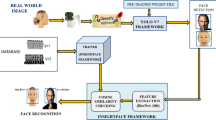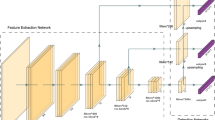Abstract
This study presents Biogeography Particle Swarm Optimization with Neural Network, which is based on Content-Based Image Retrieval and is used to solve face-related problems during face matching. A new approach is deployed called Content-Based Face Retrieval. In Content-Based Face Retrieval, face images are retrieved based on low-level features like colour and texture. A new learning method of migration of biogeographic swarm intelligence, based on Particle Swarm Optimization to cut off the local optima has been introduced. Biogeography Particle Swarm Optimization is easy to set the neural network’s weights and threshold. Biogeography Particle Swarm Optimization based on Neural Network uses the fitness function as a comparison between query and database pictures. Usually, the similarity measure function depends on colour and texture features. A colour histogram is used to determine an image’s colour feature, and filters are reused to obtain texture features. The proposed method estimates the quality check and introduces tests on the FEI dataset.








Similar content being viewed by others
References
Ababneh J (2015) Greedy particle swarm and biogeography-based optimization algorithm. Int J Intell Comput Cybern 8:28–49. https://doi.org/10.1108/IJICC-01-2014-0003
Abdull Hamed HN, Shamsuddin SM, Salim N (2008) Particle Swarm Optimization For Neural Network Learning Enhancement. J Teknol 49:13–26. https://doi.org/10.11113/jt.v49.194
Alzu’bi A, Amira A, Ramzan N (2015) Semantic content-based image retrieval: a comprehensive study. J Vis Commun Image Represent 32:20–54. https://doi.org/10.1016/j.jvcir.2015.07.012
Ayvaz MT, Kayhan AH, Ceylan H, Gurarslan G (2009) Hybridizing the harmony search algorithm with a spreadsheet ‘solver’ for solving continuous engineering optimization problems. Eng Optim 41:1119–1144. https://doi.org/10.1080/03052150902926835
Celik C, Bilge HS (2017) Content based image retrieval with sparse representations and local feature descriptors : a comparative study. Pattern Recogn 68:1–13. https://doi.org/10.1016/j.patcog.2017.03.006
Chang Y-P (2010) An ant direction hybrid differential evolution algorithm in determining the tilt angle for photovoltaic modules. Expert Syst Appl 37:5415–5422. https://doi.org/10.1016/j.eswa.2010.01.015
Chatterjee A, Siarry P, Nakib A, Blanc R (2012) An improved biogeography based optimization approach for segmentation of human head CT-scan images employing fuzzy entropy. Eng Appl Artif Intell 25:1698–1709. https://doi.org/10.1016/j.engappai.2012.02.007
Chen X, Tianfield H, Mei C, Du W, Liu G (2017) Biogeography-based learning particle swarm optimization. Soft Comput 21:7519–7541. https://doi.org/10.1007/s00500-016-2307-7
Clerc M, Kennedy J (2002) The particle swarm - explosion, stability, and convergence in a multidimensional complex space. IEEE Trans Evol Comput 6:58–73. https://doi.org/10.1109/4235.985692
Dengiz B, Altiparmak F, Belgin O (2010) Design of Reliable Communication Networks: a hybrid ant Colony optimization algorithm. IIE Trans 42:273–287. https://doi.org/10.1080/07408170903039836
Ergezer M, Simon D, Du D (October 2009) Oppositional Biogeography-Based Optimization. In: Proceedings of the 2009 IEEE International Conference on Systems, Man and Cybernetics. IEEE, San Antonio, TX, USA, pp 1009–1014
Feng Q, Liu S, Tang G, Yong L, Zhang J (2013) Biogeography-based optimization with orthogonal crossover. Math Probl Eng 2013:1–20. https://doi.org/10.1155/2013/353969
Garg S, Patra K, Pal SK (2014) Particle swarm optimization of a neural network model in a machining process. Sadhana 39:533–548. https://doi.org/10.1007/s12046-014-0244-7
Gudivada VN, Raghavan VV (1997) Modeling and retrieving images by content. Inf Process Manag 33:427–452. https://doi.org/10.1016/S0306-4573(97)00007-1
Guo W, Li W, Zhang Q, Wang L, Wu Q, Ren H (2014) Biogeography-based particle swarm optimization with fuzzy elitism and its applications to constrained engineering problems. Eng Optim 46:1465–1484. https://doi.org/10.1080/0305215X.2013.854349
Guo W, Chen M, Wang L, Mao Y, Wu Q (2017) A survey of biogeography-based optimization. Neural Comput Applic 28:1909–1926. https://doi.org/10.1007/s00521-016-2179-x
Hanmandlu M, Verma OP, Susan S, Madasu VK (2013) Color segmentation by fuzzy co-Clustering of chrominance color features. Neurocomputing 120:235–249. https://doi.org/10.1016/j.neucom.2012.09.043
Hill T, O’Connor M, Remus W (1996) Neural network models for time series forecasts. Manag Sci 42:1082–1092. https://doi.org/10.1287/mnsc.42.7.1082
Ho CK, Ewe HT (2009) GACO – a hybrid ant COLONY optimization METAHEURISTIC for the dynamic load-balanced CLUSTERING problem in ad hoc networks. Appl Artif Intell 23:570–598. https://doi.org/10.1080/08839510903161139
Hordri NF, Yuhaniz SS, Nasien D (2013) A comparison study of biogeography based optimization for optimization problems. Int J Advance Soft Comput Appl 5:16
Jain R, Johari PK (May 2016) An improved approach of CBIR using color based HSV quantization and shape based edge detection algorithm. In: Proceedings of the 2016 IEEE international conference on recent trends in electronics, Information & Communication Technology (RTEICT). Bangalore, IEEE, pp 1970–1975
Jha GK, Thulasiraman P, Thulasiram RK (June 2009) PSO Based Neural Network for Time Series Forecasting. In: Proceedings of the 2009 International Joint Conference on Neural Networks. IEEE, Atlanta, Ga, USA, pp 1422–1427
Kaipravan M, Rejiram R (March 2016) A novel CBIR system based on combination of color moment and Gabor filter. In: Proceedings of the 2016 international conference on data mining and advanced computing (SAPIENCE). Ernakulam, IEEE, pp 170–174
Kennedy J, Eberhart R (1995) Particle swarm optimization. In proceedings of the proceedings of ICNN’95 - international conference on neural networks; IEEE: Perth, WA. Australia 4:1942–1948
Khehra BS, Pharwaha APS (2017) Comparison of genetic algorithm, particle swarm optimization and biogeography-based optimization for feature selection to classify clusters of microcalcifications. J Inst Eng India Ser B 98:189–202. https://doi.org/10.1007/s40031-016-0226-8
Kobayashi M (May 2021) Two-level complex-valued Hopfield neural networks. IEEE Transac Neural Netw Learning Syst 32(5):2274–2278. https://doi.org/10.1109/TNNLS.2020.2995413
Liao TW (2010) Two hybrid differential evolution algorithms for engineering design optimization. Appl Soft Comput 10:1188–1199. https://doi.org/10.1016/j.asoc.2010.05.007
Marinakis Y, Marinaki M (2010) A hybrid genetic – particle swarm optimization algorithm for the vehicle routing problem. Expert Syst Appl 37:1446–1455. https://doi.org/10.1016/j.eswa.2009.06.085
Marinakis Y, Marinaki M, Dounias G (2010) A hybrid particle swarm optimization algorithm for the vehicle routing problem. Eng Appl Artif Intell 23:463–472. https://doi.org/10.1016/j.engappai.2010.02.002
Mo H, Xu L (2010) Biogeography Migration Algorithm for Traveling Salesman Problem. In Advances in Swarm Intelligence. In: Tan Y, Shi Y, Tan KC (eds) , vol 6145. Lecture Notes in Computer Science; Springer Berlin Heidelberg, Berlin, Heidelberg, pp 405–414 ISBN 978–3–642-13494-4
Mo H, Xu L (2015) Research of biogeography particle swarm optimization for robot path planning. Neurocomputing 148:91–99. https://doi.org/10.1016/j.neucom.2012.07.060
Niknam T (2010) A new fuzzy adaptive hybrid particle swarm optimization algorithm for non-linear, non-smooth and non-convex economic dispatch problem. Appl Energy 87:327–339. https://doi.org/10.1016/j.apenergy.2009.05.016
Niu Q, Zhang L, Li K (2014) A biogeography-based optimization algorithm with mutation strategies for model parameter estimation of solar and fuel cells. Energy Convers Manag 86:1173–1185. https://doi.org/10.1016/j.enconman.2014.06.026
Panchal VK, Singh P, College GNE, Kundra H (2009) Biogeography based satellite image classification. Int J Comput Sci Inf Secur 6:269–274
Pandey S, Wu L, Guru SM, Buyya R (2010) A Particle Swarm Optimization-Based Heuristic for Scheduling Workflow Applications in Cloud Computing Environments. In: Proceedings of the 2010 24th IEEE International Conference on Advanced Information Networking and Applications. IEEE, Perth, Australia, pp 400–407
Peng Y, Lei K, Yang X, Peng J (2020) Improved chaotic quantum-behaved particle swarm optimization algorithm for fuzzy neural network and its application. In: Mathematical problems in engineering, vol 2020, p 1
Rahmati SHA, Zandieh M (2012) A new biogeography-based optimization (BBO) algorithm for the flexible job shop scheduling problem. Int J Adv Manuf Technol 58:1115–1129. https://doi.org/10.1007/s00170-011-3437-9
Rane VA (2013) Particle swarm optimization (PSO) algorithm: parameters effect and analysis. Int J Innov Res Dev 2:8–16
Ratyal NI, Taj IA, Bajwa UI, Sajid M (2015) 3D face recognition based on pose and expression invariant alignment. Comput Electr Eng 46:241–255. https://doi.org/10.1016/j.compeleceng.2015.06.007
Rini DP, Shamsuddin SM (2011) Particle swarm optimization: technique, system and challenges. Int J Appl Inf Syst 1:33–45. https://doi.org/10.5120/ijais-3651
Rodan A, Faris H, Alqatawna J (2016) Optimizing feedforward neural networks using biogeography based optimization for E-mail spam identification. Int J Commun Netw Syst Sci 09:19–28. https://doi.org/10.4236/ijcns.2016.91002
Savsani P, Jhala RL, Savsani V (2014) Effect of hybridizing biogeography-based optimization (BBO) technique with artificial immune algorithm (AIA) and ant Colony optimization (ACO). Appl Soft Comput 21:542–553. https://doi.org/10.1016/j.asoc.2014.03.011
Simon D (2008) Biogeography-Based Optimization. IEEE Trans Evol Comput 12:702–713. https://doi.org/10.1109/TEVC.2008.919004
Simon D (2011) A probabilistic analysis of a simplified biogeography-based optimization algorithm. Evol Comput 19:167–188. https://doi.org/10.1162/EVCO_a_00018
Simon D, Ergezer M, Du D (October 2009) Population Distributions in Biogeography-Based Optimization Algorithms with Elitism. In: Proceedings of the 2009 IEEE International Conference on Systems, Man and Cybernetics. IEEE, San Antonio, TX, USA, pp 991–996
Simon D, Ergezer M, Dawei D, Rarick R (2011) Markov models for biogeography-based optimization. IEEE trans Syst Man Cybern Part B Cybern 41:299–306. https://doi.org/10.1109/TSMCB.2010.2051149
Trelea IC (2003) The particle swarm optimization algorithm: convergence analysis and parameter selection. Inf Process Lett 85:317–325. https://doi.org/10.1016/S0020-0190(02)00447-7
Wang X, Duan H, Luo D (2013) Cauchy biogeography-based optimization based on lateral inhibition for image matching. Optik 124:5447–5453. https://doi.org/10.1016/j.ijleo.2013.03.124
Wang X, Duan X, Bai X (2016) Deep sketch feature for cross-domain image retrieval. Neurocomputing 207:387–397. https://doi.org/10.1016/j.neucom.2016.04.046
Yang G-P, Liu S-Y, Zhang J-K, Feng Q-X (2013) Control and synchronization of chaotic systems by an improved biogeography-based optimization algorithm. Appl Intell 39:132–143. https://doi.org/10.1007/s10489-012-0398-0
Yogesh CK, Hariharan M, Ngadiran R, Adom AH, Yaacob S, Berkai C, Polat K (2017) A New Hybrid PSO Assisted Biogeography-Based Optimization for Emotion and Stress Recognition from Speech Signal. Expert Syst Appl 69:149–158. https://doi.org/10.1016/j.eswa.2016.10.035
Yu B, Yang Z-Z, Yao B (2009) An improved ant Colony optimization for vehicle routing problem. Eur J Oper Res 196:171–176. https://doi.org/10.1016/j.ejor.2008.02.028
Zhang G, Eddy Patuwo B, Hu MY (1998) Forecasting with Artificial Neural Networks. Int J Forecast 14:35–62. https://doi.org/10.1016/S0169-2070(97)00044-7
Zhang P, Wei P, Yu H-Y (2012) Biogeography-based optimisation search algorithm for block matching motion estimation. IET Image Process 6:1014. https://doi.org/10.1049/iet-ipr.2010.0497
Zhang N, Xiong J, Zhong J, Thompson L (2018) Feature Selection Method Using BPSO-EA with ENN Classifier. In: Eighth International Conference on Information Science and Technology (ICIST). Cordoba, Granada, and Seville, Spain. https://doi.org/10.1109/ICIST.2018.8426154
Yan W (2012) Toward automatic time-series forecasting using neural networks. IEEE Trans Neural Netw Learn Syst 23:1028–1039. https://doi.org/10.1109/TNNLS.2012.2198074
Adhikari R, Agrawal RK (2011) Effectiveness of PSO based neural network for seasonal time series forecasting. Indian Int Conf Artif Intell IICAI 15
Innocente MS, Sienz J (2011) Particle Swarm Optimization with Inertia Weight and Constriction Factor. Proc. 2011 Int Conf Swarm Intell 2011, 12.
Panchal VK, Goel S, Bhugra D, Singhania V (2011) Study on the Behaviour of BBO over Natural Terrain Features. In Proceedings of the 2011 3rd International Conference on Electronics Computer Technology; IEEE: Kanyakumari, India, pp. 28–32.
Jamil N., Lqbal S Iqbal N( 2001) Face Recognition Using Neural Networks. In Proceedings of the Proceedings. IEEE International Multi Topic Conference. IEEE INMIC 2001. Technology for the 21st Century.; IEEE: Lahore, Pakistan, 2001; pp. 277–281.
Bisi M, Divija A, Namala S, Sarap R (2020) “CNN-BPSO Model for Multi Classification of Tweets,” in IEEE 4th Conference on Information & Communication Technology (CICT), Chennai, India. https://doi.org/10.1109/CICT51604.2020.9311921
Bulbule SS, Sutaone MS, Vyas V (2019) “Robust CBFR for Forensic Application using CNN,” in TENCON 2019 - 2019 IEEE Region 10 Conference (TENCON), Kochi, India. https://doi.org/10.1109/TENCON.2019.8929301
Siegel B (August 2020) Industrial Anomaly Detection: A Comparison of Unsupervised Neural Network Architectures. IEEE Sensors Lett 4(8). https://doi.org/10.1109/LSENS.2020.3007880
Funding
There is no funding for this publication.
Author information
Authors and Affiliations
Corresponding author
Ethics declarations
Conflict of interest
It is to declare that there is no conflict of interest of any author.
Additional information
Publisher’s note
Springer Nature remains neutral with regard to jurisdictional claims in published maps and institutional affiliations.
Rights and permissions
About this article
Cite this article
Dubey, D., Tomar, G.S. BPSO based neural network approach for content-based face retrieval. Multimed Tools Appl 81, 41271–41293 (2022). https://doi.org/10.1007/s11042-022-13208-0
Received:
Revised:
Accepted:
Published:
Issue Date:
DOI: https://doi.org/10.1007/s11042-022-13208-0




